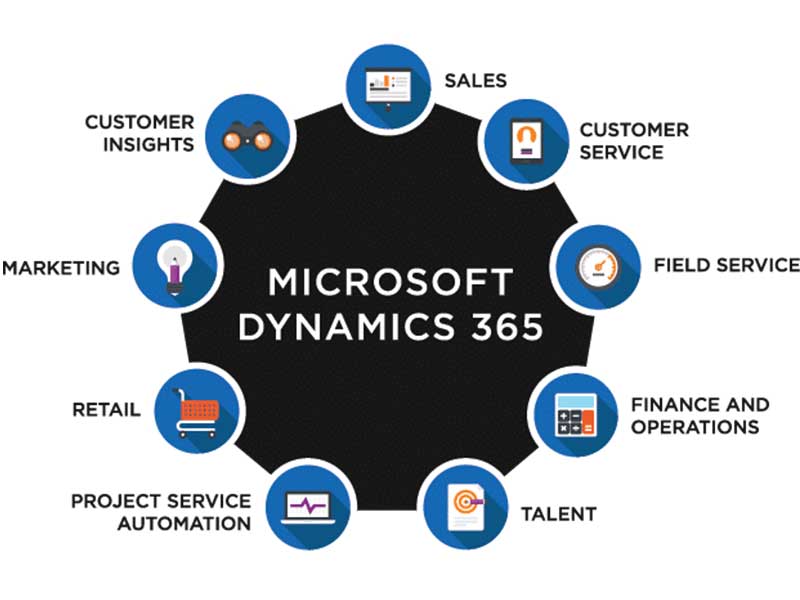Leveraging CRM or ERP Microsoft Dynamics 365 applications flexibility and efficiency have helped businesses grow and thrive. However, it still has some advantages and disadvantages that users need to consider. In this article, we will explore the top 5 pros and cons of Dynamics 365 for your reference.
Table of Contents
Microsoft Dynamics 365 Market Share
According to Statista, the Dynamics 365 app (Business Central) had 87.25 percent of the ERP market share in 2022 and dominated 1.8 million domains. Besides, according to the report from Enlyft, Dynamics 365 contributed 7.6 percent to the CRM market share, ranking 4th among the leading vendors worldwide. On the other hand, the major Dynamics 365 products have competed with others in business process management and won 48.95 percent of the market.

Top 5 Pros and Cons of Dynamics 365
Microsoft Dynamics 365 is the leading CRM or ERP application for businesses, but not all organizations can apply them due to its disadvantages. Let’s explore the top 5 pros and cons of Dynamics 365 applications.
Pros
Fully business tools
Microsoft Dynamics 365 offers a full business management tool that covers almost all organization needs. You can check Microsoft Dynamics in a Nutshell to have an overview of all Dynamics 365 applications and their features.
Highly scalable
No matter how large your business is, Dynamics 365 apps can adapt to changing needs and fit your organization. Dynamics 365 offers flexible licensing options and various functionality depending on your requirements. The users can easily add or remove accounts, integrate new apps, and modify resources as needed, without having to add additional hardware or infrastructure.
Seamless Integration feature
With Dynamics 365, users can integrate with other Microsoft products, enabling a unified data flow and leveraging all the highlights of all modules. Additionally, Dynamics 365 allows users to integrate with other third-party applications and systems, optimizing processes, improving data accuracy, and enhancing overall productivity.
Cloud-based platform
The suite of Microsoft Dynamics 365 is a cloud-based platform that allows users to access data from anywhere, using any device, at any time to work remotely. Besides, working on the cloud can save money to maintain hardware and infrastructure like working on-premises. Microsoft takes care of everything to ensure that users are always using the latest version.
Intuitive interface
Microsoft Dynamics 365 offers a user-friendly and intuitive interface, which enhances the user experience and ease of use. By providing an intuitive interface, Dynamics 365 facilitates access to the features, or functions, making it easy to interact with data, focus on the work, and improve efficiency.

Cons
Besides the various advantages of Dynamics 365, it still has some disadvantages that users need to consider. It includes factors such as cost, license, mobile interface, as well as training requirements for users.
Complex implementing cost
The implementing cost of Dynamics 365, depending on the subscriptions, is around $10,000. The users also need to pay the customization fees, training costs, and infrastructure expenses. Moreover, depending on the license type, the implementing cost will be different, including Essentials, Premium, and Team Member 5. For details, please check the Dynamics 365 pricing to have an overview of it.
Training requirements
Dynamics 365 is a powerful and complicated platform, offering various features and capabilities to support business operations efficiently. Therefore, the users need to be trained on how to leverage all Dynamics features effectively.
High Customization costs
Microsoft Dynamics 365 offers various customization options for specific business needs, but it requires additional fees. Customization can be related to modifying the user interface, adding new features, integrating with other systems, creating custom apps, or more.
Glitch mobile interface
With Dynamics 365, users can access its applications through mobile devices, but the interface can sometimes experience glitches or issues. For example, error messages, redirected URLs do not work, slow performance, limited functionality, and so on. The mobile version may not always provide the same functionality as the desktop version, which can impact satisfaction and productivity.
Server code adjustments right
Dynamics 365 allows users to work on the cloud, where Microsoft maintains and manages the server code. So, organizations will be restricted from modifying or customizing the deep-level server code. However, they can customize the application level via extensions and configuration, but highly specialized or unique requirements may be limited.
Who can use Microsoft Dynamics 365?
With the powerful CRM and ERP Dynamics 365 applications, it’s suitable for all-sized businesses from startups to large enterprises, streamlining their operations, enhancing customer relationships, improving data management, and gaining valuable insights. Some Dynamics 365 use cases and industries: Automotive, Education, Financial Services, Government, Healthcare, Manufacturing, and so on.
Conclusion
Once again, there are various pros and cons to Dynamics 365 that users should be aware of when evaluating its implementation. With a comprehensive understanding of Dynamics 365, organizations can make informed choices and leverage all its features. We hope that you can get some valuable information from this page. If you have any questions regarding Dynamics 365 or integration requirements, please feel free to contact us.















































